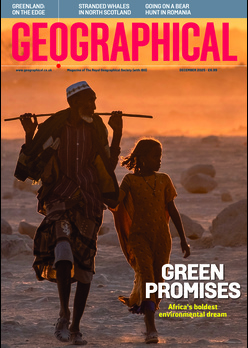
Co-existence with wolves has been marred by negative cultural biases, but WaterBear’s documentary ‘The Wolf Within’ advocates to change that
By
It can be easy to forget, but humans are still animals. Despite the distance that is often placed between us and the lives of other creatures that roam around ecosystems, we too are just another species who call our planet home.
It might seem a simple observation, but one that documentary film producer and conservation photojournalist Alessio Bariviera is keen to reiterate again and again, particularly in the context of wolves – those animals that have long been characterised as the villains of fairytale stories, or the subject of deep-rooted cultural stigmas – through his latest documentary The Wolf Within, available to watch on WaterBear.

‘Wolves challenge us to think about coexistence and respect for life outside our own species, which is something I’ve always felt passionately about,’ says Bariviera.
Long fascinated by the raw and untamed side of nature – and uncovering a variety of species struggling to survive in a rapidly changing world through his other work – Bariviera is keen to address the importance of a positive human-wolf relationship head-on while simultaneously countering the scare-mongering that often surrounds these creatures.
‘Cultural perceptions of wolves as dangerous predators are definitely a big hurdle,’ says Bariviera. And today, public opinion of the animals is still shaped by the countless folklore stories and myths which have demonised their existence.
But far from the stereotype of the ghoulish creature that howls in the middle of the night, wolves protect many of our landscapes and have a serious role in ecosystems.
Enjoying this article? Check out our related reads:
Without them, areas, including national parks, become overgrazed by elks – prey for wolves – and consequently have a lower amount of trees. In turn, this decreases the trees available for birds and beavers to be used as habitats. This flow of consequences is known to ecologists as a ‘cascade effect”, and is seen elsewhere too, highlighting the importance of wolves.
Similar cascading effects have been studied between wolves and moose, as well as wolves and scavengers, who capitalise on the carcasses of prey that wolves abandon. Without these wolves, the quantity of carcasses decreases, leaving scavengers threatened by a shortage of food.
Protecting the wolf
Since the banning of wolf hunting in Poland in the 1990s, wolf populations have been steadily recovering and spreading west to countries including Germany, Denmark and France.
The Wolf Within documents one strand of this revitalisation, across the Abruzzo and Appennino Tosco-Emiliano National Parks and the Bellunesi Dolomites regions of Italy. For Bariviera, the return of these vital players in society is something to be celebrated.

But not everyone shares the same positive opinions on wolves. Earlier this year, the majority of EU member states voted to downgrade the protection status of the wolf in Europe, allowing culling to return as a potential solution to counter livestock depredation. A petition to oppose such a decision has already begun, garnering the support of 300 NGOs along with more than 300,000 signatures from the public.
For Bariviera and others involved in the documentary, adopting alternate efforts to promote coexistence between wolves and local communities is a far more ecologically-conscious alternative than downgrading their protection status, as well as educating citizens with science-based information on wolves, including guides on appropriate behaviours to express while around the animals. This way, wolves can be protected while simultaneously ensuring they are integrated into the environment alongside humans in a safe and mutually beneficial way.
Uncovering new perspectives
Despite the ecological benefits that revitalising wolves brings – and advocating for their protection – The Wolf Within does also incorporate another nuance into its discussion: recognising the genuine concerns of farmers and hunters in Italy, who face an increase in devastating wolf attacks that maim their cattle and herds.
These perspectives, which may have otherwise been overshadowed, do feature in the documentary and are given ample room to share their concerns, offering a glimpse into a life where an increased presence of wolves can catalyse a startling shift to the success of one’s livelihood.
But on either side of the discussion – whether you’re a farmer concerned with tackling the difficulties of rising wolf populations, or a conservationist promoting their revival – The Wolf Within emphasises there is a shared goal for the future.
‘I learned that most people, whether they’re farmers, conservationists, or boar hunters, ultimately want the same thing: a balanced, thriving ecosystem,’ says Bariviera. ‘The challenge lies in finding ways to address the economic and safety concerns without sacrificing conservation.
‘The Wolf Within taught me that coexistence is possible, but it requires open dialogue and a willingness to see the situation from all perspectives – instead of dismissing opinions different from our own.’




